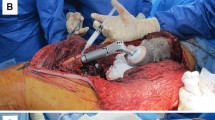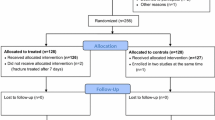Abstract
Purpose
Aim of this study was to verify the hypothesis that a one-stage exchange procedure, performed with an antibiotic-loaded, fast-resorbable hydrogel coating, provides similar infection recurrence rate than a two-stage procedure without the coating, in patients affected by peri-prosthetic joint infection (PJI).
Methods
In this two-center case–control, study, 22 patients, treated with a one-stage procedure, using implants coated with an antibiotic-loaded hydrogel [defensive antibacterial coating (DAC)], were compared with 22 retrospective matched controls, treated with a two-stage revision procedure, without the coating.
Results
At a mean follow-up of 29.3 ± 5.0 months, two patients (9.1%) in the DAC group showed an infection recurrence, compared to three patients (13.6%) in the two-stage group. Clinical scores were similar between groups, while average hospital stay and antibiotic treatment duration were significantly reduced after one-stage, compared to two-stage (18.9 ± 2.9 versus 35.8 ± 3.4 and 23.5 ± 3.3 versus 53.7 ± 5.6 days, respectively).
Conclusions
Although in a relatively limited series of patients, our data shows similar infection recurrence rate after one-stage exchange with DAC-coated implants, compared to two-stage revision without coating, with reduced overall hospitalization time and antibiotic treatment duration. These findings warrant further studies in the possible applications of antibacterial coating technologies to treat implant-related infections.
Level of evidence
III.
Similar content being viewed by others
References
Ahmad SS, Becker R, Chen AF, Kohl S (2016) EKA survey: diagnosis of prosthetic knee joint infection. Knee Surg Sports Traumatol Arthrosc 24(10):3050–3055
Berend KR, Lombardi AV Jr, Morris MJ, Bergeson AG, Adams JB, Sneller MA (2013) Two-stage treatment of hip periprosthetic joint infection is associated with a high rate of infection control but high mortality. Clin Orthop Relat Res 471(2):510–518
Boot W, Gawlitta D, Nikkels PG, Pouran B, van Rijen MH, Dhert WJ, Vogely HC (2017) Hyaluronic acid-based hydrogel coating does not affect bone apposition at the implant surface in a rabbit model. Clin Orthop Relat Res. https://doi.org/10.1007/s11999-017-5310-0
Boot W, Vogely HCH, Nikkels PGJ, Pouran B, van Rijen M, Dhert WJA, Gawlitta D (2015) Local prophylaxis of implant-related infections using a hydrogel as carrier. Eur Cells Mat 30(2):19–20
Buchholz H, Elson R, Engelbrecht E, Lodenkamper H, Rottger J, Siegel A (1981) Management of deep infection of total hip replacement. J Bone Joint Surg 63-B(3):342–353
Cancienne JM, Burrus MT, Weiss DB, Yarboro SR (2015) Applications of local antibiotics in orthopedic trauma. Orthop Clin North Am 46(4):495–510
Carlsson AS, Egund N, Gentz CF, Hussenius A, Josefsson G, Lindberg L (1985) Radiographic loosening after revision with gentamicin-containing cement for deep infection in total hip arthroplasties. Clin Orthop Relat Res 194:271–279
Chernousova S, Epple M (2013) Silver as antibacterial agent: ion, nanoparticle, and metal. Angew Chem Int Ed Engl 52:1636–1653
Choi HR, Kwon YM, Freiberg AA, Malchau H (2013) Comparison of one-stage revision with antibiotic cement versus two-stage revision results for infected total hip arthroplasty. J Arthroplasty 28(8 Suppl):66–70
Dobzyniak M, Fehring TK, Odum S (2006) Early failure in total hip arthroplasty. Clin Orthop Relat Res 447:76–78
Drago L, Boot W, Dimas K, Malizos K, Hänsch GM, Stuyck J, Gawlitta D, Romanò CL (2014) Does implant coating with antibacterial-loaded hydrogel reduce bacterial colonization and biofilm formation in vitro ? Clin Orthop Relat Res 472(11):3311–3323
Gallo J, Holinka M, Moucha CS (2014) Antibacterial surface treatment for orthopaedic implants. Int J Mol Sci 15(8):13849–13880
Garvin KL, Evans BG, Salvati EA, Brause BD (1994) Palacos gentamicin for the treatment of deep periprosthetic hip infections. Clin Orthop Relat Res 298:97–105
George DA, Logoluso N, Castellini G, Gianola S, Scarponi S, Haddad FS et al (2016) Does cemented or cementless single-stage exchange arthroplasty of chronic periprosthetic hip infections provide similar infection rates to a two-stage? A systematic review. BMC Inf Dis 16(1):553–566
Giavaresi G, Meani E, Sartori M, Ferrari A, Bellini D, Sacchetta AC, Meraner J, Sambri A, Vocale C, Sambri V, Fini M, Romanò CL (2014) Efficacy of antibacterial-loaded coating in an in vivo model of acutely highly contaminated implant. Int Orthop 38(7):1505–1512
Hardes J, von Eiff C, Streitbuerger A, Balke M, Budny T, Henrichs MP et al (2010) Reduction of periprosthetic infection with silver-coated megaprostheses in patients with bone sarcoma. J Surg Oncol 101(5):389–395
Inzana JA, Schwarz EM, Kates SL, Awad HA (2016) Biomaterials approaches to treating implant-associated osteomyelitis. Biomaterials 81:58–71
Jamsen E, Stogiannidis I, Malmivaara A, Pajamaki J, Puolakka T, Konttinen YT (2009) Outcome of prosthesis exchange for infected knee arthroplasty: the effect of treatment approach. Acta Orthop 80(1):67–77
Kapadia BH, Berg RA, Daley JA, Fritz J, Bhave A, Mont MA (2016) Periprosthetic joint infection. Lancet 387(10016):386–394
Kasch R, Assmann G, Merk S et al (2016) Economic analysis of two-stage septic revision after total hip arthroplasty: what are the relevant costs for the hospital’s orthopedic department? BMC Musculoskeletal Dis 17:112
Kasch R, Merk S, Assmann G, Lahm A, Napp M, Merk H, Flessa S (2017) Comparative analysis of direct hospital care costs between aseptic and two-stage septic knee revision. PLoS ONE 12(1):e0169558. https://doi.org/10.1371/journal.pone.0169558
Kendoff D, Gehrke T (2014) Surgical management of periprosthetic joint infection: one-stage exchange. J Knee Surg 27(4):273–278
Klouche S, Leonard P, Zeller V et al (2012) Infected total hip arthroplasty revision: one- or two-stage procedure? Orthop Traumatol Surg Res 98(2):144–150
Koh CK, Zeng I, Ravi S, Zhu M, Vince KG, Young SW (2017) Periprosthetic joint infection is the main cause of failure for modern knee arthroplasty: an analysis of 11,134 knees. Clin Orthop Relat Res. https://doi.org/10.1007/s11999-017-5396-4
Kunutsor SK, Whitehouse MR, Lenguerrand E, Blom AW, Beswick AD, INFORM Team (2016) Re-Infection outcomes following one- and two-stage surgical revision of infected knee prosthesis: a systematic review and meta-analysis. PLoS ONE 11(3):e0151537
Hochreiter B, Strahm C, Behrend H (2016) Short-interval two-stage approach to primary total knee arthroplasty for acutely septic osteoarthritic knees. Knee Surg Sports Traumatol Arthrosc 24(10):3115–3121
Lange J, Troelsen A, Thomsen RW, Soballe K (2012) Chronic infections in hip arthroplasties: comparing risk of reinfection following one-stage and two-stage revision: a systematic review and meta-analysis. Clin Epidem 4:57–73
Li P, Hou M, Zhu ZQ, Shi ZJ (2015) Cementless revision for infected hip arthroplasty: an 8.6 years follow-up. Orthop Surg 7(1):37–42
Malizos K, Blauth M, Danita A, Capuano N, Mezzoprete R, Logoluso N, Drago L, Romanò CL (2017) Fast-resorbable antibiotic-loaded hydrogel coating to reduce post-surgical infection after internal osteosynthesis: a multicenter randomized controlled trial. J Orthop Traum. https://doi.org/10.1007/s10195-017-0442-2
Malizos K, Scarponi S, Simon K, Blauth M, Romanò C (2015) Clinical results of an anti-bacterial hydrogel coating of implants: a multi-centre, prospective, comparative study. Bone Joint J 97-B(16):138–139
Massin P, Delory T, Lhotellier L, Pasquier G, Roche O, Cazenave A, Estellat C, Jenny JY (2016) Infection recurrence factors in one- and two-stage total knee prosthesis exchanges. Knee Surg Sports Traumatol Arthrosc 24(10):3131–3139
McPherson EJ, Woodson C, Holtom P, Roidis N, Shufelt C, Patzakis M (2002) Periprosthetic total hip infection: outcomes using a staging system. Clin Orthop Rel Res 403:8–15
Mijnendonckx K, Leys N, Mahillon J, Silver S, van Houdt R (2013) Antimicrobial silver: uses, toxicity and potential for resistance. Biometals 26:609–621
Mühlhofer HM, Pohlig F, Kanz KG, Lenze U, Lenze F, Toepfer A, Kelch S, Harrasser N, von Eisenhart-Rothe R, Schauwecker J (2017) Prosthetic joint infection development of an evidence-based diagnostic algorithm. Eur J Med Res 22(1):8–23
Nagra NS, Hamilton TW, Ganatra S, Murray DW, Pandit H (2016) One-stage versus two-stage exchange arthroplasty for infected total knee arthroplasty: a systematic review. Knee Surg Sports Traumatol Arthrosc 24(10):3106–3114
Noda I, Miyaji F, Ando Y, Miyamoto H, Shimazaki T, Yonekura Y et al (2009) Development of novel thermal sprayed antibacterial coating and evaluation of release properties of silver ions. J Biomed Mater Res B 89:456–465
Osmon DR, Berbari EF, Berendt AR, Lew D, Zimmerli W, Steckelberg JM, Rao N, Hanssen A, Wilson AR (2013) Infectious diseases society of America. Executive summary: diagnosis and management of prosthetic joint infection: clinical practice guidelines by the Infectious diseases society of America. Clin Infect Dis 56(1):1–10
Parvizi J, Pawasarat IM, Azzam KA, Joshi A, Hansen EN, Bozic KJ (2010) Periprosthetic joint infection: the economic impact of methicillin-resistant infections. J Arthropl 25(6):103–107
Parvizi J, Zmistowski B, Berbari EF et al (2011) New definition for periprosthetic joint infection: from the Workgroup of the Musculoskeletal Infection Society. Clin Orthop Relat Res 469(11):2992–2994
Rietbergen L, Kuiper JW, Walgrave S, Hak L, Colen S (2016) Quality of life after staged revision for infected total hip arthroplasty: a systematic review. Hip Int 26(4):311–318
Romanò CL, Malizos K, Capuano N, Mezzoprete R, D’Arienzo M, Van Der Straeten C, Scarponi S, Drago L (2016) Does an antibiotic-loaded hydrogel coating reduce early post-surgical infection after joint arthroplasty ? J Bone Joint Infect 1:34–41
Romanò CL, Romanò D, Logoluso N, Meani E (2010) Septic versus aseptic hip revision: how different? J Orthop Traumat 11(3):167–174
Romanò CL, Scarponi S, Gallazzi E, Romanò D, Drago L (2015) Antibacterial coating of implants in orthopaedics and trauma: a classification proposal in an evolving panorama. J Orthop Surg Res 10:157–168
Scoccianti G, Frenos F, Beltrami G, Campanacci DA, Capanna R (2016) Levels of silver ions in body fluids and clinical results in silver-coated megaprostheses after tumour, trauma or failed arthroplasty. Injury 47(Suppl 4):S11–S16
Ulrich SD, Seyler TM, Bennett D et al (2008) Total hip arthroplasties: what are the reasons for revision? Int Orthop 32(5):597–604
Yoo JJ, Kwon YS, Koo KH, Yoon KS, Kim YM, Kim HJ (2009) One-stage cementless revision arthroplasty for infected hip replacements. Int Orthop 33(5):1195–1201
Wafa H, Grimer RJ, Reddy K, Jeys L, Abudu A, Carter SR et al (2015) Retrospective evaluation of the incidence of early periprosthetic infection with silver-treated endoprostheses in high-risk patients: case–control study. Bone Joint J 97-B(2):252–257
Winkler H, Stoiber A, Kaudela K, Winter F, Menschik F (2008) One stage uncemented revision of infected total hip replacement using cancellous allograft bone impregnated with antibiotics. J Bone Joint Surg Br 90(12):1580–1584
Wolf M, Clar H, Friesenbichler J et al (2014) Prosthetic joint infection following total hip replacement: results of one-stage versus two-stage exchange. Int Orthop 38(7):1363–1368
Wolf CF, Gu NY, Doctor JN, Manner PA, Leopold SS (2011) Comparison of one and two-stage revision of total hip arthroplasty complicated by infection: a Markov expected-utility decision analysis. J Bone Joint Surg 93(7):631–639
Wroblewski BM (1986) One-stage revision of infected cemented total hip arthroplasty. Clin Orthop Relat Res 211:103–107
Funding
The authors report no financial support.
Author information
Authors and Affiliations
Contributions
NC and CLR were involved in study design, data collection, results interpretation and writing the manuscript. NL, EG and LD were involved in data collection, results interpretation and reviewing of the manuscript.
Corresponding author
Ethics declarations
Conflict of interest
CLR has received consulting fees from Novagenit Srl. The other authors declare that they have no conflict of interest.
Ethical approval
All investigations were conducted in conformity with ethical principles of research and institutional approval of the human protocol for this investigation was obtained.
Informed consent
Informed consent for participation in the study was obtained.
Rights and permissions
About this article
Cite this article
Capuano, N., Logoluso, N., Gallazzi, E. et al. One-stage exchange with antibacterial hydrogel coated implants provides similar results to two-stage revision, without the coating, for the treatment of peri-prosthetic infection. Knee Surg Sports Traumatol Arthrosc 26, 3362–3367 (2018). https://doi.org/10.1007/s00167-018-4896-4
Received:
Accepted:
Published:
Issue Date:
DOI: https://doi.org/10.1007/s00167-018-4896-4




